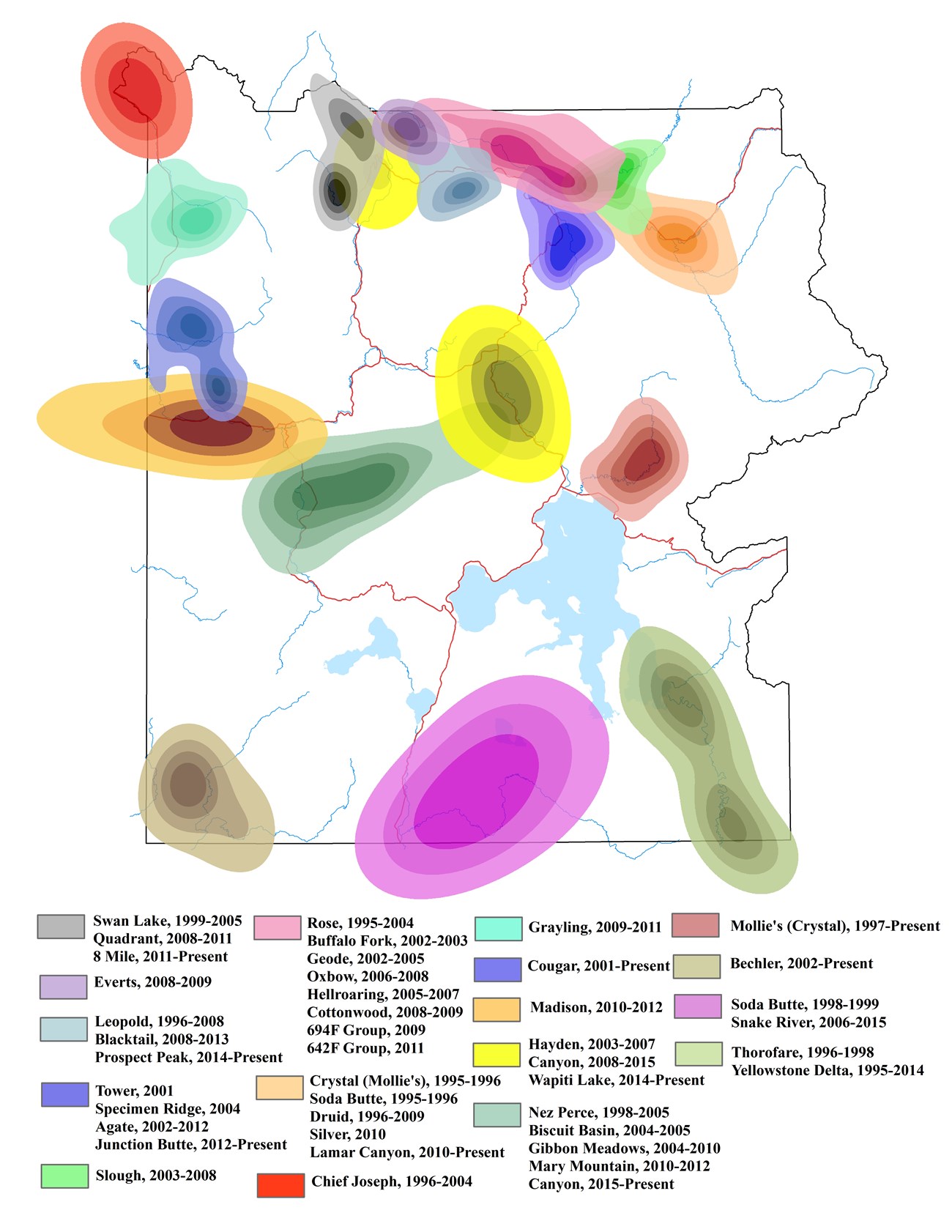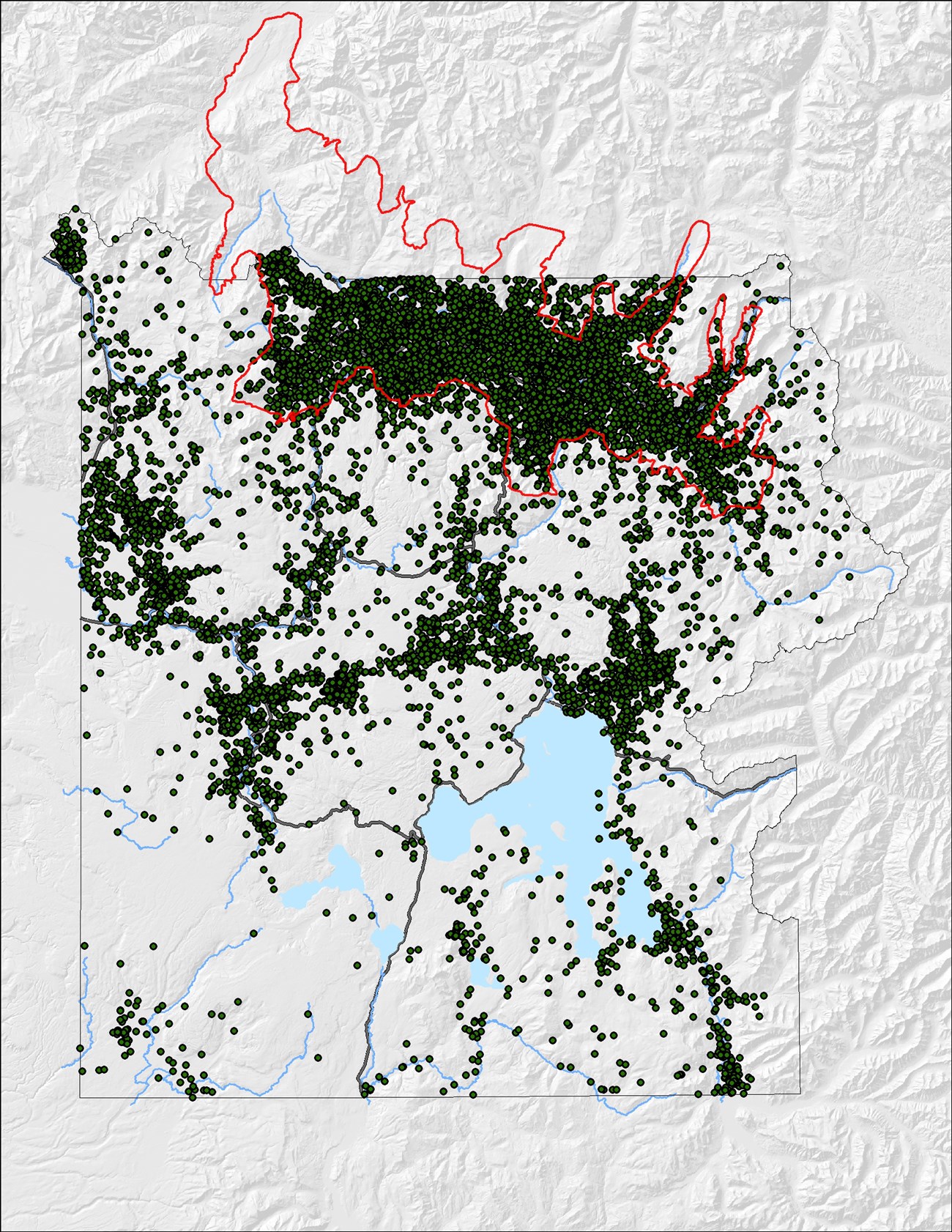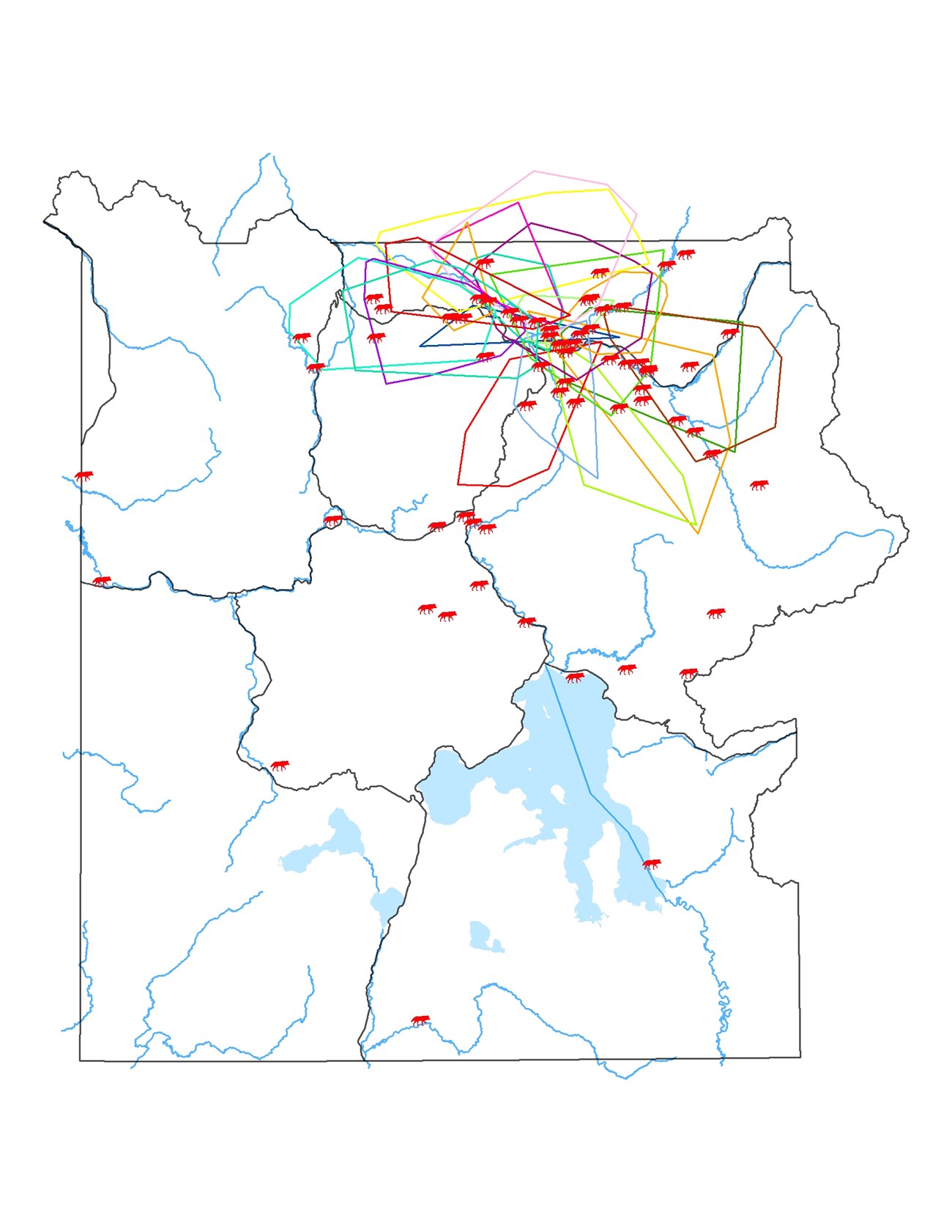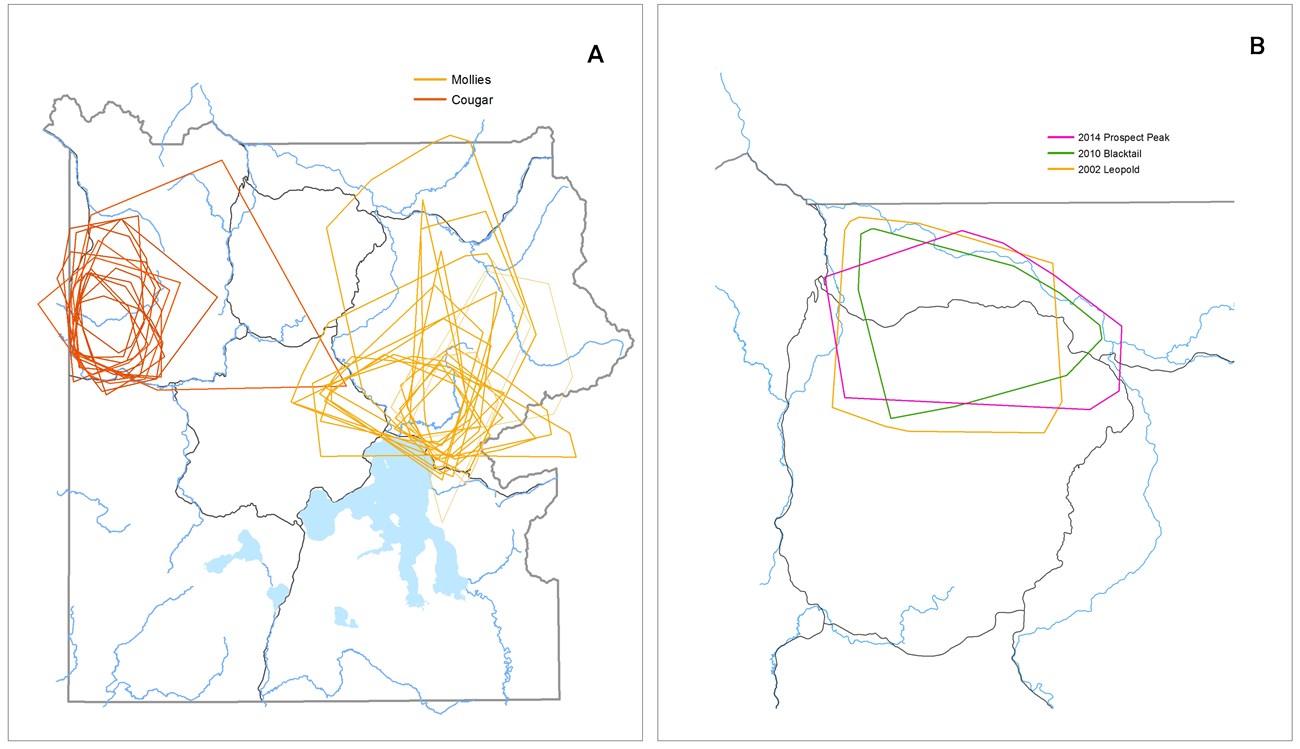Part of a series of articles titled Yellowstone Science - Volume 24 Issue 1: Celebrating 20 Years of Wolves.
Article
Wolf Turf: A Glimpse at 20 Years of Wolf Spatial Ecology in Yellowstone

Figure 1. Spatial distribution of wolf pack territory use in Yellowstone National Park over 20 years (1995-2015). Aerial locations of collared wolves were used to generate Kernel density estimations for geographic areas used by different packs over time. Gradients of color from light to dark depict increasing concentrations of use, identifying areas most important to Yellowstone wolves.
Wolf Turf: A Glimpse at 20 Years of Wolf Spatial Ecology in Yellowstone
by Erin E. Stahler, Douglas W. Smith, & Daniel R. Stahler
Territoriality is one of several well-known characteristics of wolf natural history that has presumably evolved in response to selection for behaviors advantageous to individual reproduction and survival. Worldwide, territory characteristics vary depending on ecological conditions (e.g., prey and competitor density), geographical features, seasonal changes, and human presence (Mech and Boitani 2003). However, what nearly all wolf populations share is an aggregation of territories where packs actively defend and compete for areas that provide access to critical resources, such as vulnerable prey and offspring rearing space. Numerous studies have converged on the idea that wolf spatial ecology is shaped primarily by prey, social interactions, and geography. And the last two decades of work in Yellowstone contributes to this understanding.
Looking at any single year of wolf pack territories in Yellowstone gives general pack location information and provides insight about the social and ecological conditions for that year (see map, page 9). But by comparing 20 years of territory maps, patterns emerge which tell a story about what parts of Yellowstone National Park are important to wolves (figure 1). Contrary to what is portrayed in a map, territory boundaries are not static or well defined. Instead, they are constantly changing, expanding and contracting, as packs compete with their neighbors. This can make defining and mapping wolf territories somewhat challenging. Various statistical methods exist for mapping territories, and choosing one method over another depends on the questions being asked or how a territory is defined. With all of these caveats in consideration, the annual mapping of territories still gives insight into some of the basic underlying factors driving wolf spatial dynamics.
Colonization after Reintroduction
In the first few years following reintroduction, wolves explored the landscape and established territories quickly. Some packs, like the Leopold pack, began concentrating their movements in a specific area right away (i.e., Blacktail Plateau). While other packs, like the Soda Butte pack, roamed more widely and shifted considerably from year-to-year before finally choosing an area to settle down. During this initial colonization period, packs competed over specific areas of the park even though plenty of unoccupied habitat was available. For example, the Druid Peak pack in 1996 displaced the Crystal Creek pack to take over Lamar Valley. However, overall competition was relatively low due to lower wolf densities. Less competition early on translated to more flexibility in movement because what often limits a pack, other than available prey, is constraint caused by neighbors. From 1998 and on, a mosaic pattern of wolf territories began to emerge, which is typical for established wolf populations. Territories in the northern portion of the park (known as the northern range) started compressing in size as wolf density and number of new packs increased. With these changes came increased strife and competition.
Northern Range vs. Interior
When examining a map depicting all recorded locations of radio collared wolves over the last 20 years, a striking pattern emerges (figure 2). The story this map tells is one different from a map of the park’s geothermal features or prime visitor attractions. It’s a story of what geographical and ecological features of Yellowstone’s 2.2 million acres are most attractive to wolves. One obvious pattern is the high concentration of wolf use on the northern range, with greater dispersion in the interior. These two major areas of the park are characterized by differences in elevation, vegetative communities, and weather patterns—all of which influence seasonal ungulate densities and, therefore, predator use. Packs living in the interior (e.g., Mollie’s, Cougar, Yellowstone Delta, Bechler) cannot rely on elk, their favored prey, year-round. At the onset of winter, most elk migrate to the northern range or outside the park, leaving little behind but the more formidable and difficult to kill bison. Because the northern range is important wintering range for most ungulates, especially elk, wolf density is higher. One result of higher density is greater turf wars which can lower individual wolf survival (Cubaynes et al. 2014). A more beneficial outcome is that there may be greater opportunities to find potential mates, which can lead to new pack formation.

From a spatial perspective, we see wolf territories on the northern range overlapping more. Packs may avoid using these areas of overlap simultaneously to reduce conflict—howling may help mitigate this. However, despite wolves’ attempts to avoid each other, there seems to be a link between overlap, conflict, and pack turnover. In particular, the Hellroaring and Tower Junction areas consistently have the most territorial overlap between packs throughout all years and also have the highest rate of pack turnover, often due to loss of individuals resulting from conflict (figure 3). In addition, higher pack turnover may also be associated with proximity to the park boundary in which human influences (i.e., wolf harvests or illegal poaching) may play a role. Losing individuals to either natural or human-caused mortality may be a tipping point that disrupts the social dynamics of a pack and their ability to maintain a territory (Cassidy et al. 2015). So, why do packs try and establish themselves in this area time and time again? Likely because it is prime winter habitat for elk and has landscape features conducive for successful hunting. Several river drainages converge in this area, and the valley bottoms may provide prime areas for wolf-elk encounters (Hebblewhite et al. 2005, Kauffman et al. 2007).
Contrary to territories on the northern range, wolf packs in the interior have more interstitial space between territories and experience less inter-pack competition. If we think of packs as distinct family lineages, those in the interior tend to experience longer persistence, or lower pack turnover rates, due in part to fewer territorial contests. For instance, the Crystal Creek pack, which was renamed Mollie’s in 2000, is the only pack in Yellowstone to persist for the last 20 years. In addition, Almberg et al. (2012) found packs in the interior have a lower risk of disease transmission likely due to lower territory overlap and wolf density. Disease was a major contributor toward the demise of three packs on the northern range, but we have not seen this in the interior. However, living in the interior is not easy; a limiting factor for packs may be finding vulnerable prey during the winter. It has not been uncommon for interior packs (e.g., Mollie’s, Hayden, Canyon, Cougar, Nez Perce, Mary Mountain) to travel into the northern range for short periods during winter—a time when vulnerable prey is less likely available in their own territory. For example, during the winter of 2011-2012, the 19-member Mollie’s pack spent more time on the northern range making kills than in their home range of Pelican Valley. What caused this behavior is likely a combination of factors. First, there was a large number of wolves with little access to vulnerable prey in their core territory of Pelican Valley. Second, the absence of a dominant male—killed the previous fall—may have caused pack females to seek potential mates during the breeding season on the northern range where there was a greater probability of encountering a mate due to density. Seasonal territory shifts to find prey is not uncommon and is characteristic in other wolf populations worldwide (Mech and Boitani 2003). Since most of these movements happen during the winter, this suggests both hunting opportunities and hormones influence wolf extra-territorial forays in Yellowstone.


In addition to how seasonal prey abundance and wolf density shape the spatial ecology of Yellowstone wolves, geography plays an important role. As we look at wolf territories throughout the years, packs utilize a core area, often in the middle of their territory. Interestingly, these regions remain relatively constant through time, both for the same pack from year-to-year and among packs from different time periods (figure 4a and 4b). These core areas are usually surrounded by distinct topographical features, such as significant mountainous terrain and major river drainages, and serve as natural boundaries (much like a moat surrounding a castle). Such boundaries appear to influence territorial movement patterns and inter-pack encounters, and likely help mitigate the costs of territorial defense. Whether for offspring rearing space or hunting opportunities, some regions are just prime areas for wolves. Kauffman et al. (2007) suggested wolf territories are influenced by physical landscape features that favor hunting success.
Other areas provide great homesites; we see the same den and rendezvous sites used year after year, even by unrelated individuals from different packs. These landscape features clearly influence wolf spatial patterns in consistent ways; however, we also see how the role of kinship and individual knowledge transfers are important. For example, we see cases where females inherit their mother’s breeding position and continue the spatial legacy of their relatives (e.g., 478F of Cougar Creek). In other cases, dispersed individuals return to their natal lands with their own newly formed pack (e.g., 302M of Blacktail). Together, these patterns reflect the collective influences of individuals and their surrounding environments on wolf territory use.
There is more to be learned about the spatial ecology of Yellowstone’s wolves. Future work aims to evaluate how kinship ties between packs may influence spatial and temporal organization on the landscape, and how territorial quality can be measured and correlated with wolf survival and reproductive success. For now, each location recorded from a collared wolf contributes a valuable piece towards understanding the territorial mosaic for Yellowstone wolves. When combined with the other long-term datasets, a richer picture and better understanding of this creature is revealed.
Literature Cited
Almberg E.S., P.C. Cross, A.P. Dobson, D.W. Smith, and P.J. Hudson. 2012. Parasite invasion following host reintroduction: a case study of Yellowstone’s wolves. The Royal Society B: Biological Sciences 367:2840-2851.
Cassidy, K.A., D.R. MacNulty, D.R. Stahler, D.W. Smith, and L.D. Mech. 2015. Group composition effects on interpack aggressive interactions of gray wolves in Yellowstone National Park. Behavioral Ecology. doi: 10.1093/beheco/arv081
Cubaynes, S., D.R. MacNulty, D.R. Stahler, K.A. Quimby, D.W. Smith, and T. Coulson. 2014. Density-dependent intraspecific aggression regulates survival in northern Yellowstone wolves (Canis lupus). Journal of Animal Ecology 83:1344-1356.
Hebblewhite, M., E.H. Merrill, and T.L. McDonald. 2005. Spatial decomposition of predation risk using resource selection functions: an example in a wolf-elk predator-prey system. Oikos 111:101-111.
Kauffman, M.J., N. Varley, D.W. Smith, D.R. Stahler, D.R. MacNulty, and M.S. Boyce. 2007. Landscape heterogeneity shapes predation in a newly restored predator-prey system. Ecology Letters 10:690-700.
Mech, L.D., and L. Boitani. 2003. Wolves: behavior, ecology and conservation. University of Chicago Press, Chicago, Illinois, USA.
Erin Stahler works as a Biological Science Technician for the Yellowstone Wolf Project. In 2004, she graduated from St. Olaf College, MN, with a bachelor’s degree in Biology. After college, Erin worked at the International Wolf Center in Ely, MN, and volunteered for the Superior National Forest wolf study under Dr. L. David Mech, where she helped radio collar her first wolf. Erin volunteered for different projects, including documenting tracks for Canada lynx through the University of Minnesota-Duluth and banding waterfowl for the Minnesota Department of Natural Resources. In 2005, she came to Yellowstone as a technician on an elk calf survival and mortality study. This study connected Erin to the Yellowstone Wolf Project, where in 2006, she worked as a technician on the Druid Road Management Project. After completing a total of six winter studies, she was hired as the project’s permanent Biological Technician in 2008. In addition to her role in conducting field work, aerial monitoring, and wolf capture, Erin serves as the Program Manager maintaining the project’s databases, equipment, and organizing the volunteer technician staff. Erin has helped radio collar over 90 wolves in Yellowstone.
Last updated: May 16, 2019
